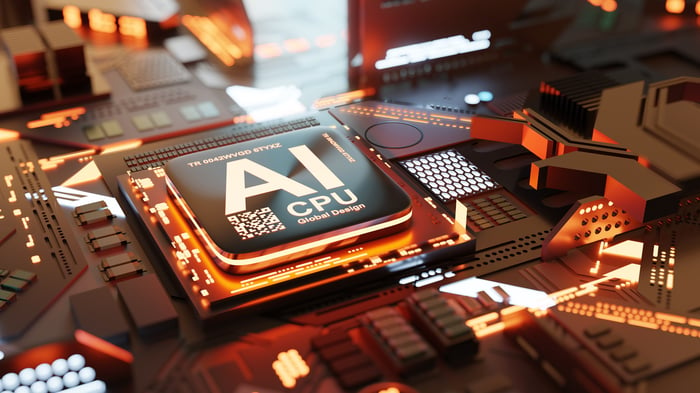A Once-in-a-Generation Investment Opportunity: 1 Artificial Intelligence (AI) Growth Stock to Buy Now and Hold Forever

There’s been a great deal of buzz over the past year or so about the impact of artificial intelligence (AI). The consensus is that these recent advances are groundbreaking and will increase human productivity severalfold by automating a growing number of otherwise time-consuming tasks. As businesses scramble to profit from these advances, some fear the market has entered an AI bubble.
Arm Holdings (ARM 0.41%) CEO Rene Haas leaves no doubt about which camp he falls in. “AI is not in any way, shape, or form a hype cycle,” he opined. “We believe that AI is the most profound opportunity in our lifetimes, and we’re only at the beginning.”
While it might seem like hyperbole, many in technology circles are adopting that view. Estimates run the gamut, but the potential economic impact could be immense. Generative AI is estimated to be worth between $2.6 trillion and $4.4 trillion annually, according to global management consulting firm McKinsey & Company. Companies on the bleeding edge of this secular tailwind could end up reaping a veritable windfall.
It’s no coincidence that Arm Holdings is one of these companies and has positioned itself to profit from the AI revolution.

Image source: Getty Images.
A vast library of intellectual property
To understand Arm’s place in the vast AI ecosystem, it helps to know a bit about the company’s strategy. Arm Holdings was founded in 1990, intent on changing the computing industry. After a product failure in 1993, the company changed its business model. Arm began developing and licensing chip designs rather than the chips themselves, and its pivot to intellectual property (IP) was complete.
Over the next two decades, Arm became a force in the semiconductor industry, creating and licensing blueprints for some of the world’s most widely used chips. The company’s expertise can be found in a range of devices, including smartphones, tablets, personal computers, and smart TVs. In fact, Arm estimates that its processors are used by 70% of the world’s population. The key here is that its AI-centric designs are prolific in cloud computing, hyperscale computing, and data centers.
Because Arm creates and licenses its processor designs, it achieves significant economies of scale and can do so at a much lower cost than most companies could achieve on their own.
The vast opportunity of AI
If Nvidia is the king of AI, Arm Holdings is arguably the queen.
Nvidia’s graphics processing units (GPUs) are the gold standard for training and running AI models. What does this have to do with Arm? The company’s high-end central processing units (CPUs) play a key role in AI processing. For example, Nvidia’s GH200 Grace Hopper Superchip — which integrates accelerated CPU and GPU technology to meet the computational demands of AI — uses 144 Arm version 9 (V9) CPU cores.
It isn’t just Nvidia that’s dependent on Arm’s newest processor. Microsoft‘s new AI-centric server chips contain more than 100 of them. In a recent interview, Haas pointed out that many customers are switching to the V9. Not only does this core offer greater processing power, but it comes at twice the royalty rate of its forerunner — which will be a boon to Arm.
The secular tailwind of AI is beginning to show up in Arm’s results. For the company’s fiscal 2024 third quarter (ended Dec. 31, 2023), Arm generated record revenue that grew 14% year over year to $824 million, fueled by license revenue that jumped 18%, and record royalty revenue that increased 11%. This resulted in adjusted earnings per share (EPS) of $0.29, an increase of 32%. But that only tells part of the story.
Arm’s remaining performance obligation (RPO) — or contractually obligated sales that haven’t yet shown up in revenue — climbed to $2.43 billion, up 38% year over year. This suggests that its revenue growth will likely continue to accelerate.
Management’s forecast seems to support that assertion. In the fourth quarter, Arm’s outlook calls for revenue in a range of $850 million to $900 million, representing growth of between 34% and 42% — more than double its 14% growth in the third quarter.
To kick off its GPU Technology Conference (GTC) last week, Nvidia debuted its long-awaited Blackwell architecture, which takes AI processing to the next level. The Blackwell GB200 superchip contains two B200 GPUs and one Arm-based Grace CPU. While specific details are still sparse, this will undoubtedly cement Arm’s place in the AI revolution.
For investors who depend on the most common valuation metrics, Arm can be tricky. The stock currently trades for 109 times forward earnings and 34 times next year’s sales. However, these metrics fail to consider Arm’s significant growth trajectory. The forward price/earnings-to-growth (PEG) ratio — which factors in this growth — is less than 1, the standard for an undervalued stock.
Given Arm’s decades of expertise, its ubiquitous chip blueprints, and the accelerating demand for AI, Arm could represent a once-in-a-generation investment opportunity.
Danny Vena has positions in Microsoft and Nvidia. The Motley Fool has positions in and recommends Microsoft and Nvidia. The Motley Fool recommends the following options: long January 2026 $395 calls on Microsoft and short January 2026 $405 calls on Microsoft. The Motley Fool has a disclosure policy.
Source link




